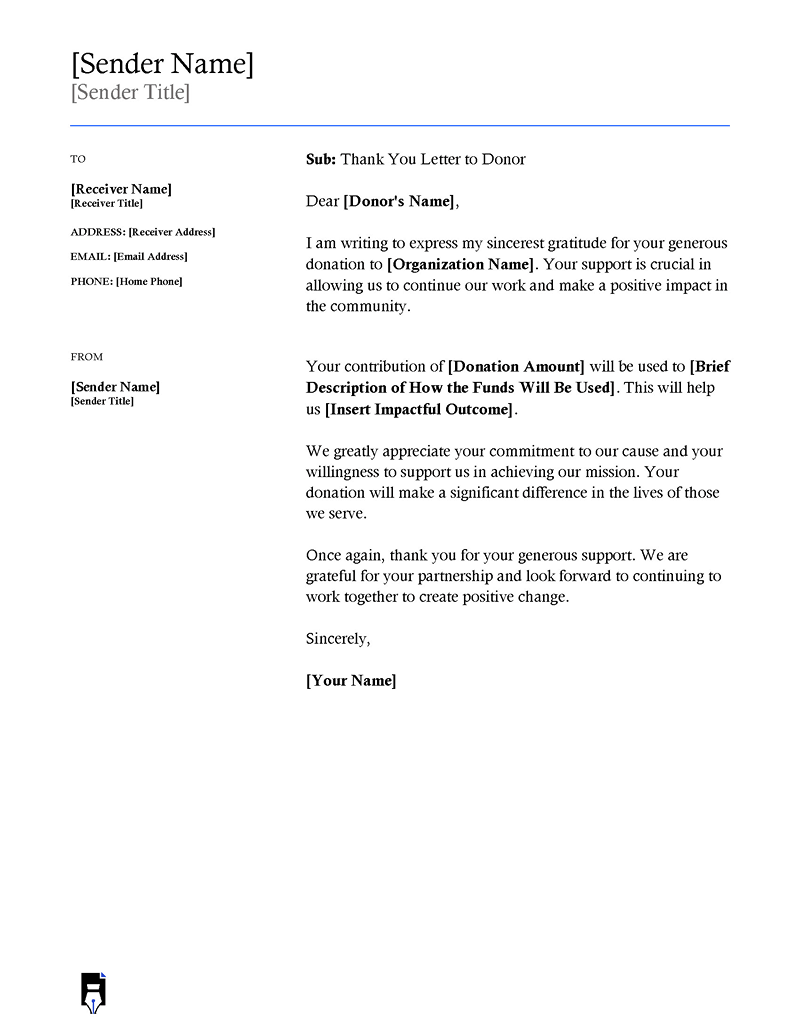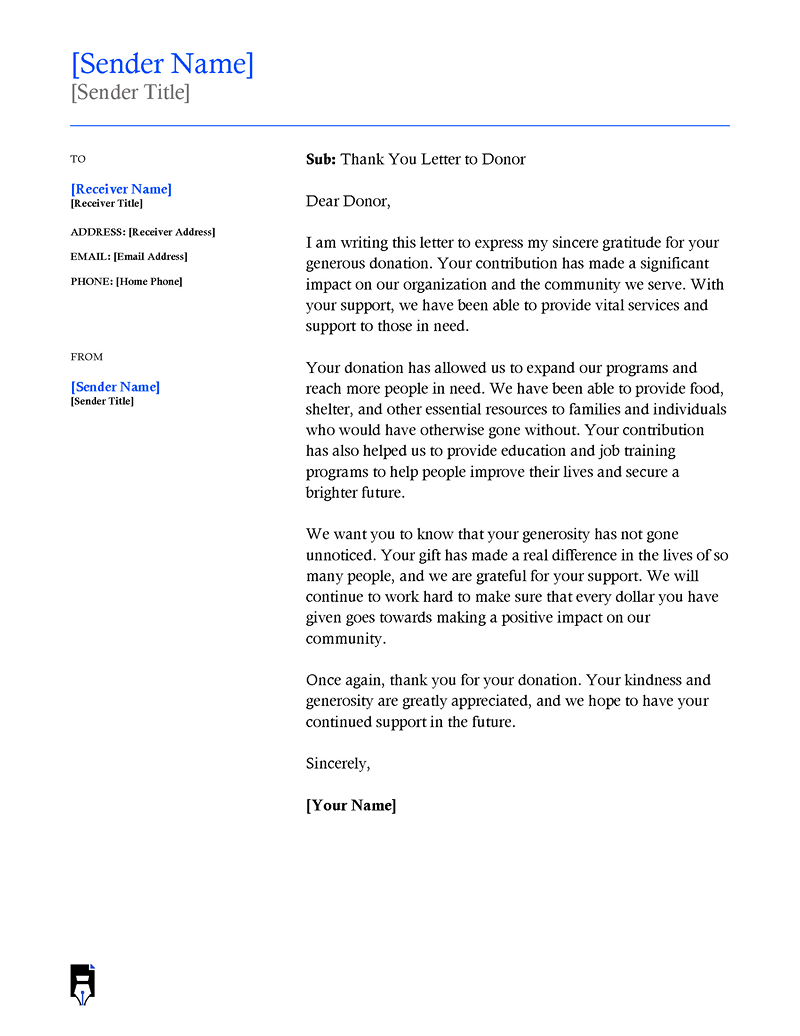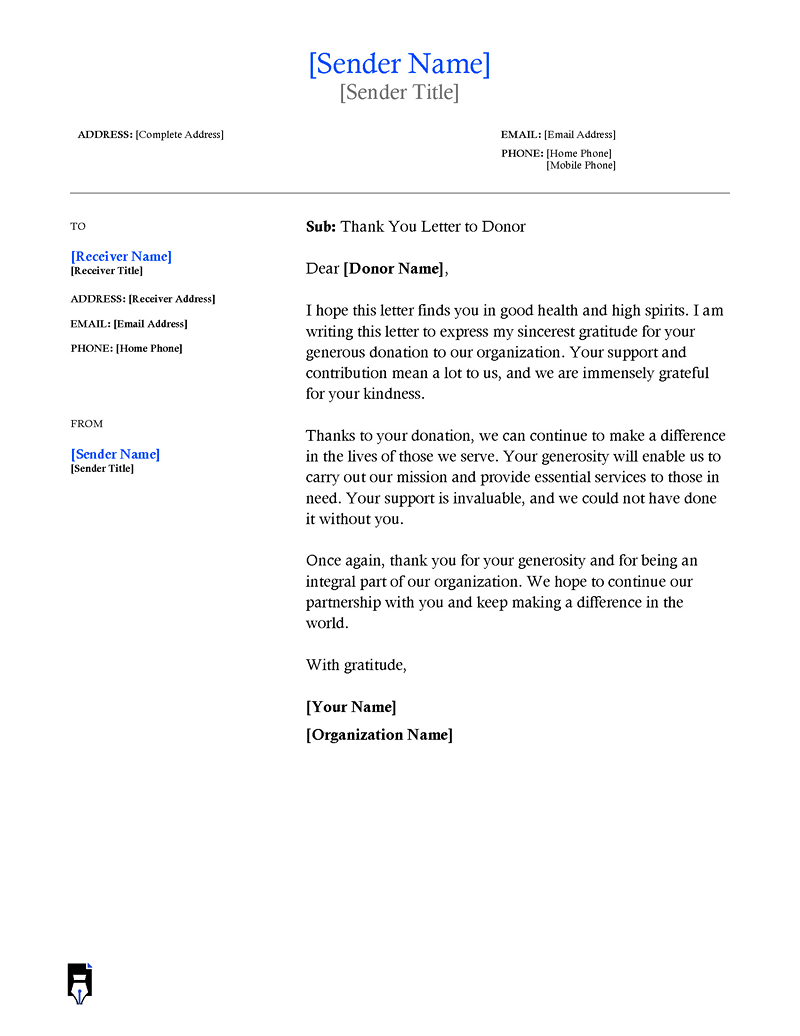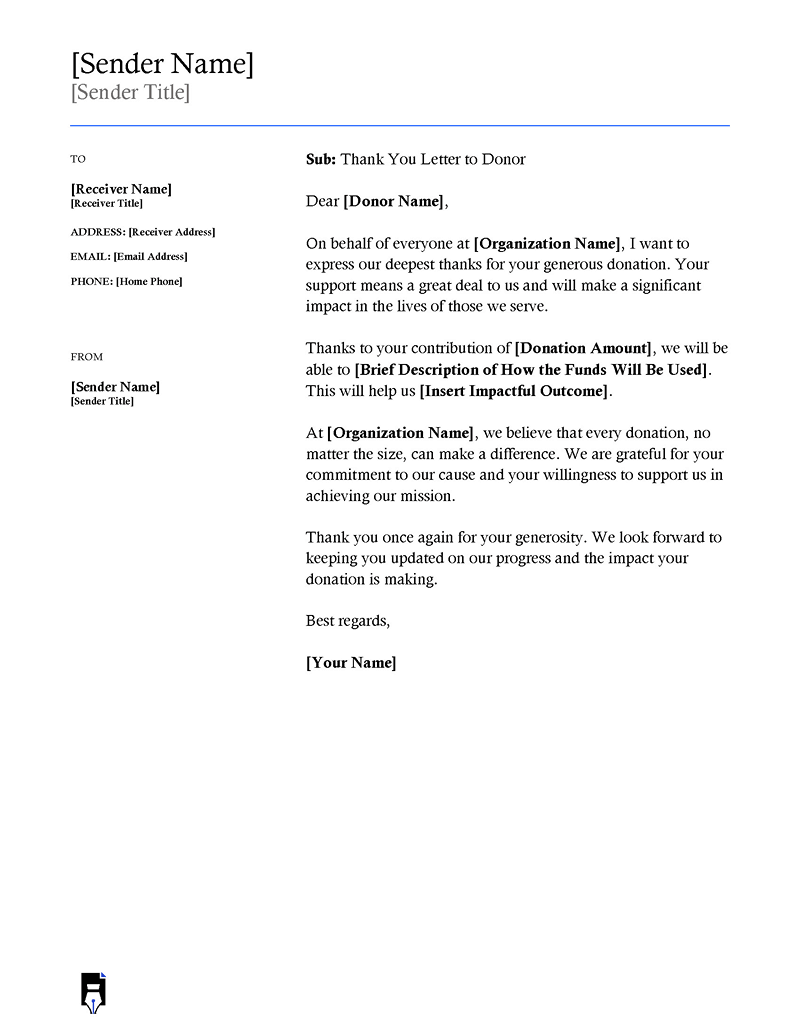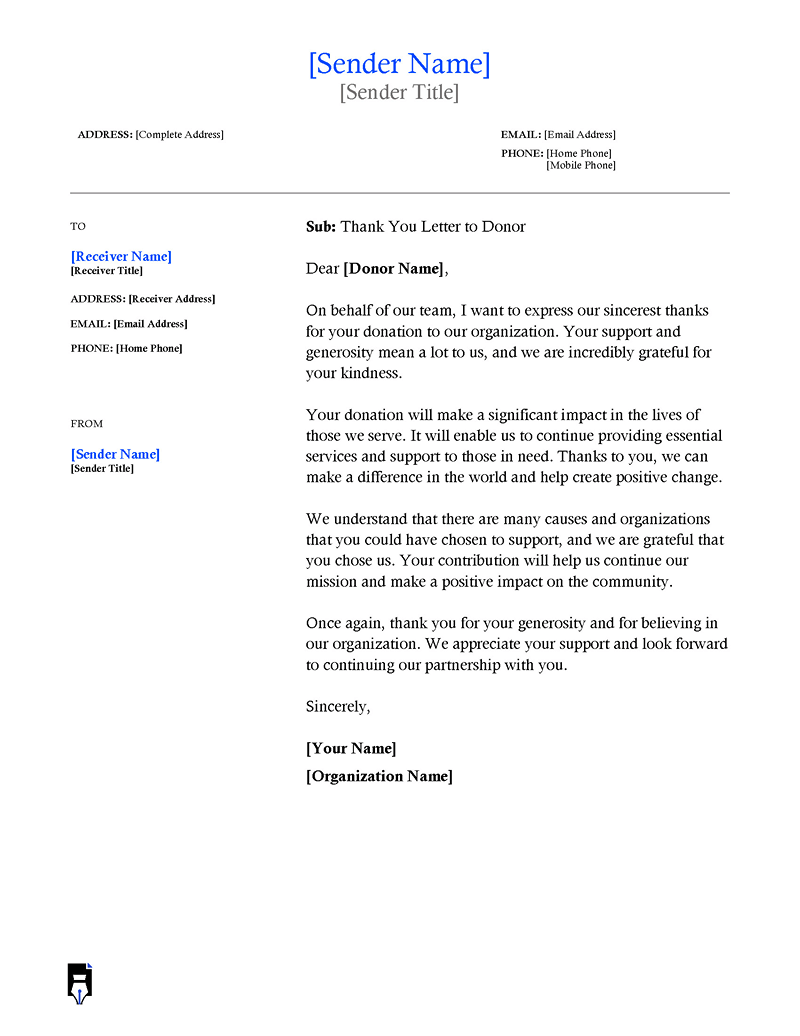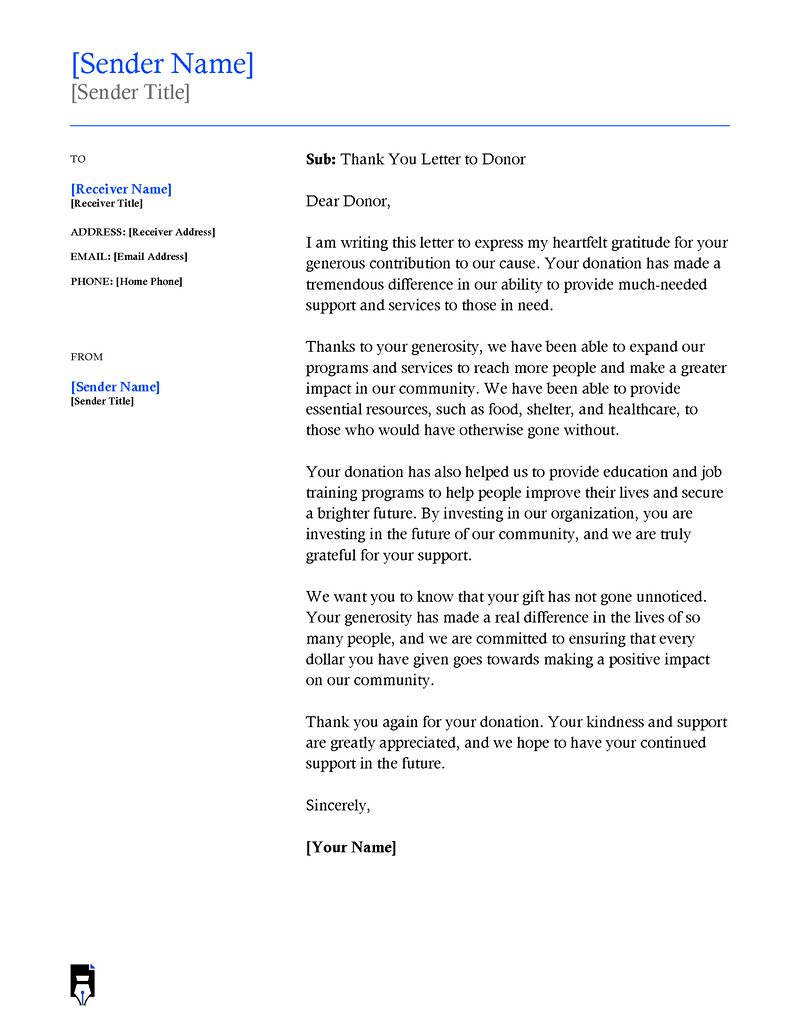Donors are an essential part of any organization. Their contributions, whether in kind or cash, ensure that day-to-day matters and projects of the organization remain functional and successful. As such, it is crucial that they feel appreciated. This appreciation can be communicated through a thank you letter. It is a document sent to donors acknowledging their contribution to your organization. Besides expressing gratitude, it is also a way to remain in contact with the donor. This article would be an excellent place to start if you want to write a thank you letter.
This article discusses the following:
- The importance of writing a thank you letter to donors
- The format of a thank you letter
- Best tips and practices when writing your letter
- How to share a thank you letter
Letter Templates
If you run an organization, you may have to write these letters to your donors constantly. Therefore, writing letters from scratch may be difficult whenever you need one. Thank you letter templates are one of the best tools to use when writing to donors. They can help you save time spent on writing new letters every time.
We provide free downloadable and editable thank you letter templates below:
Why is it Important to Write Thank You Letter to Donors?
A thank you letter may seem unnecessary because most donors volunteer to help and contribute. However, it is essential to send a thank you letter to the donors because of the following reasons:
To express gratitude
By writing a thank you letter, you acknowledge that your donor made the right choice by contributing to your charity. In return, the donor feels appreciated that their contribution made a difference.
To make the donor feel valued
Most charity projects depend on donors’ contributions; therefore, it is crucial to inform them of their importance to the success of your projects. You can use a thank you letter because it is one of the most preferred ways to make the donors feel valued.
Thank you letters often mention a specific impact made by the contribution; this allows the donor to see the value of their contribution.
To nurture the relationship between you and the donor
Donors are like clients; appreciating them makes it easier for them to contribute to your organization in the future. The relationship between an organization and a donor is strengthened by personal appreciation, and the donor often feels connected when they receive the letter.
Leads to good donor stewardship
Beyond creating a good relationship with your organization, an appreciation letter promotes the feeling of loyalty. It encourages the donor to maintain their relationship, and they may even bring more donors with similar interests.
Do you know? Most donors make one-time contributions. It is expensive to look for new donors, and it is also not easy to retain donors. The average retention rate is 19.2%, increasing by 39% when donors are given personalized thank-you letters. These donors often fail to give again because of poor communication; this can be prevented by sending thank-you notes.
Format of a Thank You Letter to Donor
A thank you letter should be positive and objective; it should help you keep a line of communication with your donor. When writing it, you should ensure it shows how thankful you are while giving particulars of the contribution.
You should follow the format given below:
Introduction
The introduction should be written carefully because it creates a lasting impression on the donor. Therefore, it should be brief and personal. When writing your introduction, begin by mentioning your donor’s name and thank them while mentioning their contribution amount.
When you mention the contribution, it reminds your donor how much they gave and makes the letter feel more personal. Your first paragraph should be at least two to three lines long. After the paragraph, you may mention the organization’s work as a reminder to the donor.
Body
The body is the main chunk of the letter. It should explain the impact of the donor’s contribution; there are various ways of demonstrating this impact. You may give a short story and state what project you used the money for or what items were purchased using the contribution. You should focus on ensuring the donor understands how much their contribution helped your organization. Therefore, you should direct the letter to appreciate the donor instead of discussing your organization.
Conclusion
The conclusion of your letter should serve two purposes. First, to further appreciate your donor, which is the central theme of your letter. Second, encourage your donor to get more involved through a call for action. You may include other ways they can contribute, for example volunteering in person or their time and skills or joining your organization’s giving program.
The call for action should be persuasive but not aggressive to ensure the donor does not feel pressured to give. You should maintain the overall appreciation theme and establish a connection with the donor.
Tip: After concluding your letter, you should sign off with an authentic signature. The letter should maintain a personal tone throughout, and the signature is one of the ways to do this. You can also include an additional note from a director or beneficiary of the charity. If you wish to add some information, ensure it is handwritten.
Sample of a Thank You Letter to Donors
January 15, 2019.
Betty Wilkins,
673 Oobervile Drive,
Aukland, Oklahoma.
Dear Betty,
We express our gratitude for your $500 contribution to Metro Community Centre. Through your donation, we could buy toys for our children and pay to repair our playground equipment. Your donation helped us achieve our two objectives just before the summer holidays.
We established this community center to create a healthier environment for children in this community to play and interact with each other. Their playtime is essential to their health and development, and it had recently become harder to maintain equipment as we could not afford to repair the broken swings and slides.
We are writing to acknowledge your donation and are grateful to you. Please consider this letter as a receipt for your contribution.
Once again, we thank you for your generosity and support. We look forward to hearing from you and interacting more. Should you have any questions, please contact us via 555-6779 233 or [email protected].
Sincerely,
Keenan Grace,
Executive Director.
Tips and Best Practices for Thank You Letter to Donors
Your letter is a follow-up to the donor, reminding them of your appreciation and establishing a long-lasting relationship. It, therefore, needs to be well-written to help you communicate your appreciation.
You can use the tips below to ensure your letter is effective in achieving your objectives:
Send it promptly
Donors often forget about donations as they may be contributing to many organizations at once. As the writer, you want the donor to remember your organization; this can be done by sending a thank you letter promptly after receiving a donation. The recommended period is two weeks.
Show the impact of the donation
Your letter should be as specific as possible on the donation’s impact. You may mention the part of a project completed because of the donation or that a student’s fee was fully paid, and they could complete their schooling. When you mention such details, the donor feels valued.
Make it personalized
You can make the letter personal by using a friendly tone and mentioning the donor’s name in the salutation. Be as specific as possible with names, and avoid using generic salutations and signing off phrases. Generic phrases make the letter look automated rather than customized to them.
Avoid making a direct request
The main aim of writing your letter is to express gratitude. As such, you should avoid requesting donations at the same time. It may give the donor the impression that the letter is asking for another donation rather than thanking them. If you have to include a request, you can send another letter asking for a donation.
Include a tax receipt
It is good practice to include tax receipts in your letter for the benefit of the donor. According to the IRS, you should issue a receipt for a donation of $250 or more. Generally, issuing receipts is an acknowledgment, and it shows accountability.
Consider the format
Your letter could be shared through different means of communication. As such, you should consider your recipients. Older donors may prefer to receive the letter in their mail, while younger donors are more likely to embrace emails. You should employ different methods to suit the preferences of your donors.
Take care of the tone
It is crucial to remember that the letter is a personal appreciation. Therefore, the tone of your letter should be positive and genuine. You should avoid using a formal tone as it may sound stiff and detached. You should also consider your donor and use appropriate tones for different donors; for example, you cannot use the same tone with an individual and a corporation.
Proofread the letter
Your letter is professional communication; this should be portrayed in the letter. You should proofread it to correct any grammar and spelling mistakes. Further, proofreading allows you to gauge the general tone and flow of the letter. When proofreading your letter, you should check for jargon the donor may not understand and use simple language.
Make them feel they are important
Your donor should always feel valued, even for smaller donations. You should emphasize their importance to the organization. You can also mention how their contributions have helped you succeed in completing a project or task.
Prepare in advance
As an organization, you may receive many donations and be overwhelmed by the number of letters you have to write. You can prepare thank you letter templates in advance and edit them with a personalized touch when you need to use them. Preparation in advance helps you to send the letters promptly.
How to Send Your Thank You Letter to a Donor?
Now that you have your thank you letter, you need to consider the most suitable way to share it with your donor. The distribution method depends on many factors, like the information you have and the donor’s preferred mode of communication.
The two most commonly used methods include the following:
By email
You can send your letter electronically if you have the donor’s email. However, this method has its advantages and disadvantages. On the pros side, it is quick, efficient, and environmentally sound. On the cons side, emails may appear impersonal and cold. In addition, some people may not want to receive emails, and some may never be opened. Also, you may not always have the donor’s email.
By post mail
Post mail is convenient and more personal than email. It is also very likely that the donor will open it once they receive it. On the contrary, post mail is slower, more expensive, and less environmentally friendly. Further, these letters should reach the donor within two weeks; post mail may be harder to achieve and may result in losing a valuable donor.
Of the two methods, the best method depends on the donor, their preference, and the type of donation. If the donor mailed their donation, it is advisable to respond similarly by mailing your letter. On the other hand, if the donor made a significant donation, it is advisable to send a letter as it appears more personal. Finally, emailing the letter would be more convenient if the donor donated online. Where you find it challenging to select the best method, you may ask the donor about their preference.
Wrapping Up
Your thank you letter should open a line of communication with the donor. In addition, it helps to create a solid relationship to promote loyalty for future donations. For the above reasons, your letter must maintain a personal touch. Therefore, you should be as specific as possible on the contributions and their impact. You can also make the letter more effective by telling impact stories and adding notes from the organization’s director or other high-ranking members.
